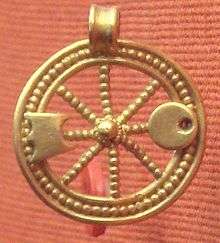Endovelicus
Endovelicus (also Endouellicus, Endovélico in Portuguese), was an Iron Age god of public health and safety, worshipped in pre-Roman and Roman Lusitania and Gallaecia. He was associated with chthonic oracles and healing, and was probably the recipient of pig sacrifices. After the Roman invasion, his cult spread to most of the Roman Empire, but was always most popular in the Roman provinces of Lusitania (covering most of what is now Portugal) and Betica (located in Southern Spain). Thus he is considered part of the Roman mythology and the related Lusitanian and Gallaecian mythology.
Endovelicus has a temple in São Miguel da Mota in Alentejo, Portugal, and there are numerous inscriptions and ex-votos dedicated to him in the Museu Etnológico de Lisboa (the Ethnological Museum of Lisbon). The cult of Endovelicus prevailed until the 5th century, just when Christianity was spreading in the region.
Powers
Endovelicus was a supreme solar healing god, thus a god of Medicine. Some suspect he was also a god who wore several faces, one of which may have been an "infernal" one, since all solar gods went down to the infernos and returned with healing power.
After receiving certain rites, if a person or priest slept in his sanctuary, Endovelicus would talk to them in their dreams and even tell them about their own future or offer advice.
Endovelicus also protected the cities or region that venerated him. The epithets given to Endovelicus are deus, sanctus, prarsentissimus and preaestantissimus. These suggest that the god was effective, and always present and living on the sanctuary. Votive altars suggest that the god inspired the early Lusitanian resistance against the Romans.The epithets also suggest that he was the chief deity of his pantheon.
The name
In the 19th century, António da Visitação Freire classified the name of "Endovelicus" as a mixed Celtic and Phoenician name, adapted to the Roman language. The End- radical would be from Celtic languages; Bel (or Vel-) would be Phoenician for Lord and - Cus a usual word termination in Latin. José Leite de Vasconcelos believed the word Endovellicus was originally Celtic, Andevellicos, meaning very good.
Temples and cult
As a powerful Lusitanian God, the Romans also adopted it and his cult spread to other regions of the Empire.
In the municipality of Alandroal, there is the Santuário da Rocha da Mina (Mina's Rock Sanctuary); some authors classify it as a temple of Endovelicus. It is the only known place of this kind in Southern Portugal. Near the temple, we can find the Lucefecit rivulet that has been associated with Lucifer since the Middle Ages. Lucifer was the name used by the Romans for the Morning star and the goddess Venus. Some authors connect the name of the rivulet with the meaning of the place as being the "Glimpse of Light". A kilometer away, there is a sacred fountain that is said to be more ancient than the temple; its waters are still considered medicinal.
The temple is rocky and hemmed in by a rocky formation that protects the site and the chiselled flooring is often related to Roman sacrificial altars. This sort of monument is not uncommon in the North of Portugal and on the Spanish Meseta.
Leite de Vasconcelos mentions that the site was used by Roman people from all walks of life. Several inscriptions suggest that the temple of Endovelicus was used as an oracle. One of the inscriptions states: EX IMPERATO AVERNO. Leite de Vasconcelos translated this as “segundo a determinação que emanou de baixo" (by the determination that emanated from below) suggesting that there is a similarity to the Temple of Apollo at Delphi. Steam would emanate from below, deep within the earth, and bestow clairvoyance. Vasconcelos also suggests that believers practiced the incubatio, sleeping at the site, hoping for dreams they could interpret later.
In Castro de Ulaca in Ávila, a city on the border of the ancient province of Lusitania, a sanctuary dedicated to Vaelicus has been discovered. The name could be related to Endovelicus.
The most notable sanctuary hypothetically dedicated to Endovelicus, is the Roman Sanctuary of Panóias in Vila Real, Trás-os-Montes, with a complex system of "sinks" bearing Roman inscriptions. Nearby, in Cabeço de São Miguel da Mota, another temple dedicated to Endovelicus was built and, on its ruins, the Alans built or readapted the previous temple, a sanctuary dedicated to Saint Michael (São Miguel in Portuguese). The Muslims transformed the temple into a mosque, and with the Reconquista the temple was once again made a Christian temple. In 1559 the temple was still somewhat well preserved when the Cardinal Henrique ordered 96 marble columns to be removed from the place to build the Colégio do Espírito Santo in Évora. From the building only the staging remained. But archaeological forays have turned up pottery and amphorae as well as votive altars dedicated to Endovelicus, and lead to the discovery of several architectural elements, among them the "sinks" made in the rocks. The sinks suggests the existence of rituals, animal sacrifice and, possibly, feasts of a ritual nature.
References
- Loução, Paulo Alexandre: Portugal, Terra de Mistérios Ésquilo, 2000 (third edition; ISBN 972-8605-04-8).
- Michael Jordan, Encyclopedia of Gods, Kyle Cathie Limited, 2002

